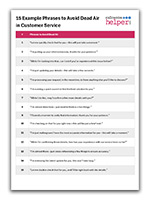Silence might be golden in some settings, but in customer service, it can be a red flag. Dead air time – those awkward pauses during a call or chat – can quickly make customers feel forgotten, frustrated, or unsure of what’s happening.
Whether it’s caused by searching for information or figuring out the next step, too much silence can damage rapport.
In this article, we break down what dead air time is, why it matters, and how contact centres can tackle it head-on with simple, effective techniques.
What Is Dead Air Time In Customer Service?
Dead air time refers to periods of silence or inactivity during customer service interactions such as phone calls or live chats.
In a call centre setting, dead air time typically occurs when there is a gap between the customer’s statements and the representative’s response.
This can happen when the agent is searching for information, processing a request, or thinking about how to respond.
While brief pauses are sometimes necessary, excessive dead air time can lead to customer frustration or discomfort, as it may seem like the representative is unsure or unprepared. Effective customer service agents are trained to minimize dead air by using a variety of techniques.
7 Tips to Avoid Call Centre Dead Air Time
Here are seven pieces of advice to help avoid dead air time in customer service calls and enhance the quality of customer–advisor conversations.
1. Teach Advisors Some Polite Phrases
It may be useful to arm customer service advisors with some examples of phrases to use when the line goes quiet, as leaving the customer “stranded” not only damages rapport but could also be considered rude.
“if a customer says ‘hello? Are you still there?’ Then that’s the best feedback that you haven’t got it quite right.
Working as quickly and efficiently as possible, while the customer is on the line, and making good use of manners goes a long way. So, advisors should be using phrases such as: ‘Sorry to keep you waiting, thank you for your patience.’
Customers are usually very tolerant if you keep them informed and they feel that you are really trying to help, and that you not just being slow or ignorant.” – Carolyn Blunt
2. Ask Advisors to Tell the Customer What They Are Doing
In terms of what contact centre advisors can do to reduce and even avoid dead air time, Carolyn Blunt thinks that it is “important for advisors to keep customers informed of what they are doing.”
Not only will the customer appreciate the update, but they will recognise that the advisor is still actively working to solve their query.
“It’s not necessary to jabber on senselessly all the time, especially if the advisor is reading notes or thinking.
Phrases such as ‘I’m just going to go quiet for a minute while I read where this is up to’ works.
Equally, using hold appropriately works so the customer receives hold music and knows they haven’t been cut off.” – Carolyn
Equally, using hold appropriately works so the customer receives hold music and knows they haven’t been cut off.”
Doing this helps to avoid the dreaded “tumbleweed moment”, as Carolyn calls it. This is where the “customer makes a joke or a little comment and the agent ignores it. There is usually an awkward, brief silence before the agent moves on.”
If you want to find more on how to “avoid the tumbleweed”, read our article: Rapport-Building Tips
3. Review and Update Your Knowledge Management System
Dead air time during customer service calls is often the result of slow search systems or poorly indexed systems that advisors struggle to navigate.
As Carolyn explains: “advisors may be looking for an answer or an update and can’t find what they need quickly enough because of the lack of updates or adequate indexing or searchable tags in the knowledge management system.”
So, reviewing the navigation and speed of the contact centre’s knowledge management system is a useful activity, as “these things need to be addressed in the first instance.”
4. Inform Customers of Promotions and Incentives
While this won’t work when handling a tough query, as it may look as though the advisor is side-tracking, this will certainly provide an advisor with enough material to fill dead air time, while also promoting the company.
So, this can be a useful when waiting for slow systems. But an advisor must be careful when choosing which customer to give this information to.
Advisors should avoid informing angry customers of promotions or incentives when handling their query, because opportunities to spend more money with a company they are already upset with will be the last thing they want to hear.
For more on what agents should avoid saying, read our article: Words and Phrases an Advisor Should NEVER Say to an Angry Customer
5. Engage in Small Talk and Retrieve Customer Information
While some advisors may be more skilled than others when it comes to small talk, it can be a useful tool to put the customer at ease and find out more about them.
If an advisor is sociable, general chitchat – about the weather, for example – can help pass the time, while building rapport.
Moreover, the customer information that the advisor retrieves can be entered into the CRM system for the next advisor who handles a call from the very same customer to see. This will make it easier for them to build rapport and provide better customer service.
For example, if the customer were to say that they were originally from Scotland, the advisor could note this in the CRM system.
If the customer were to then call back, the next advisor could then reference a piece of recent news related to Scotland as a shortcut to building rapport.
To find out some more similar tips to help to build rapport, read our article: 27 Effective Ways to Build Customer Rapport
6. Press the Hold Button When Needed
It is true that being put on “hold” can irritate customers, but the sound of music is an improvement over complete silence.
While this function should only ever be used for long waiting times, it must also come after a warning that prepares the customer for any dead air time.
This warning should be phrased in a way that is similar to the following example: “To help you resolve this matter, I am going to [INSERT TASK]. So, I am going to put you on hold for [INSERT TIME] and when I get back we should be able to…”
The time guarantee is important as it will allow the customer to gauge if they have enough time to attend to other tasks in the meantime.
For any duty that will take longer than a couple of minutes, offering the customer a callback is best practice, so frustration doesn’t build while on tenterhooks.
7. Target Call Anomalies in Quality Monitoring
When working with contact centres, Dave Salisbury MBA, a Professional Customer Interactions Developer, reviews Average Handling Time (AHT) to see how it can be reduced without compromising quality of service.
In doing so, Dave Salisbury says, “I am looking for anomalies, calls that are too long, and listening to them using standard call quality software.”
This increases the chances of pinpointing advisors who are struggling to reduce dead air time.
These advisors can then be given on-the-job training, where they are taught “techniques to physically move to avoid dead air time,” such as those listed above.
For advice on how to improve your contact centre quality monitoring, read our article: 30 Tips to Improve Your Call Quality Monitoring
Phrases to Avoid Dead Air in Customer Service Calls
If you want to give your agents some guidance on how to avoid dead air in conversations, we’ve put together 15 statements for you to use in your call centre:
- “Let me quickly check that for you – this will just take a moment.”
- “I’m pulling up your information now, thanks for your patience.”
- “While I’m looking into that, can I ask if you’ve experienced this issue before?”
- “I’m just updating your details – this will take a few seconds.”
- “I’m processing your request; in the meantime, is there anything else you’d like to discuss?”
- “I’m running a quick search to find the best solution for you.”
- “While I do this, may I confirm a few more details with you?”
- “I’m almost done here – just need to finalize a few things.”
- “I’ll need a moment to verify that information; thank you for your patience.”
- “I’m checking on that for you right now – this will be just a brief wait.”
- “I’m just making sure I have the most accurate information for you – this will take a moment.”
- “While I’m confirming those details, how has your experience with our service been so far?”
- “I’m almost there – just cross-referencing a few things to ensure accuracy.”
- “I’m retrieving the latest update for you, this won’t take long.”
- “Let me double-check that for you, and I’ll be right back with the details.”
Printable – 10 Example Phrases to Avoid Dead Air
Do you want to download this to share with your team?
Get your free printable download of 10 Example Phrases to Avoid Dead Air for Customer Service now:
For more advice on call handling techniques, read these articles next:
- What to Say to an Angry Customer
- “I’d Like to Speak to a Manager” – 7 Ways to Deal With Difficult Customers
- Assurance Statements in Customer Service – With Examples
Author: Megan Jones
Reviewed by: Hannah Swankie
Published On: 9th Oct 2017 - Last modified: 12th Aug 2025
Read more about - Hints and Tips, Call Handling, Carolyn Blunt, Dave Salisbury, Free Downloads, Knowledge Management, Language, Rapport






































